Pierogi Ruskies: Potatoes. Cheese. Butter. The Polish are genius – this is dumpling heaven! A great weekend project – cook some now, freeze some for later. They cook from frozen!!

A Pierogi Ruskie recipe
I’m so excited to be bringing you this Pierogi recipe! I’d eat them every day if they didn’t tip the scales in the wrong direction. 😭
Even if you haven’t tried a Pierogi before, all you need to know is that these ones are cheesy, creamy mashed potato filled dumplings served with an intensely butter onion sauce.
In other words, it is every Cheese-Lovin’ Carb Monster’s Dream come true, and she who is the self appointed Head Priestess of this Club was literally in mind-boggling ecstasy when faced with a plate of these.
They are, to say the least, one of the most delicious things I’ve eaten this year!

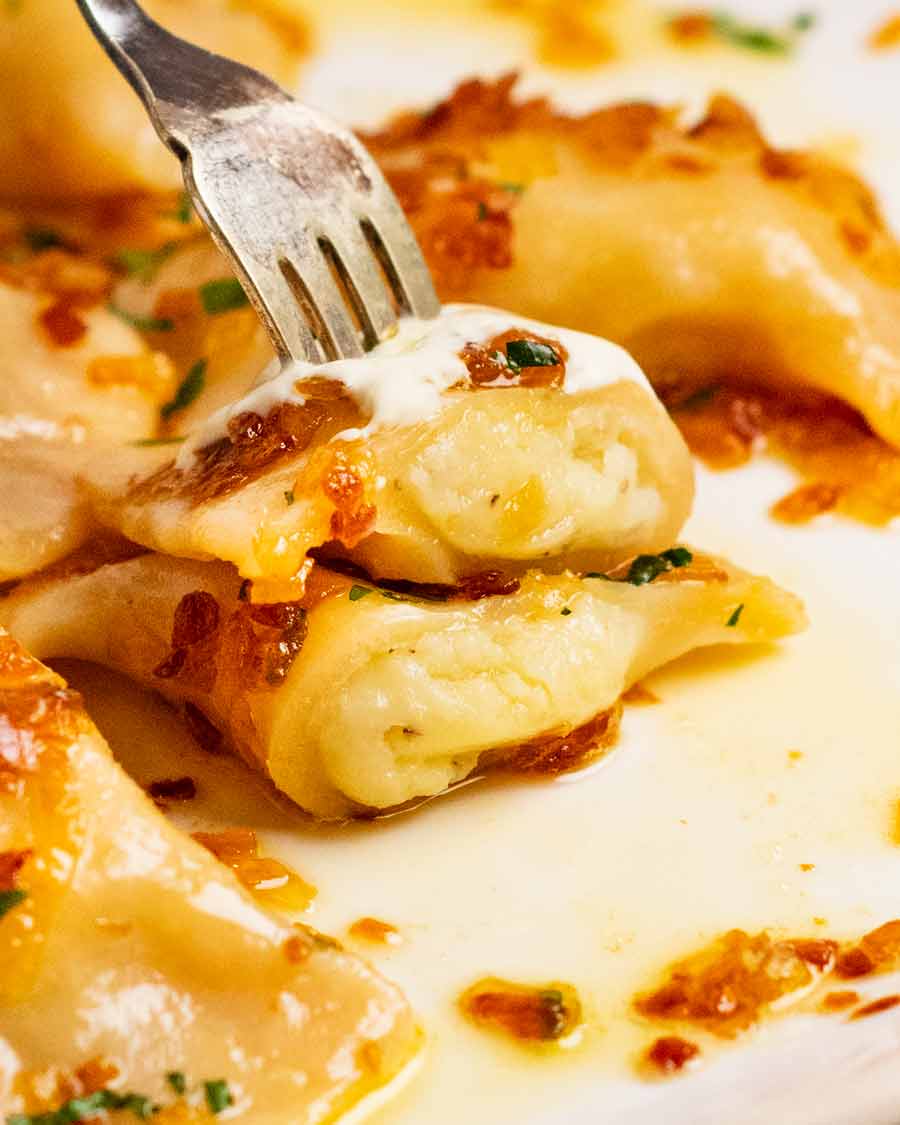
What are Pierogi?
Pierogi are Eastern European stuffed dumplings that are usually boiled. As with many traditional foods, there are regional varieties with fillings ranging from sweet to savoury, meat to meatless.
This potato and cheese-filled Pierogi recipe I’m sharing today is a meatless kind popular in Poland. The filling? Cheese! Potato! Butter! Even if you’ve never had one before, these three words already mean you know you’re going to love it!
What they taste like: Pierogis are heartier and heftier than Asian dumplings like gyoza and Chinese potstickers. The dumpling wrapper is thicker and the filling is often rich. The dumpling itself is also bigger and heavier, and often topped with a sauce of melted butter. Tt may not be the lightest of meals but it will be one of the best things you eat this month!!
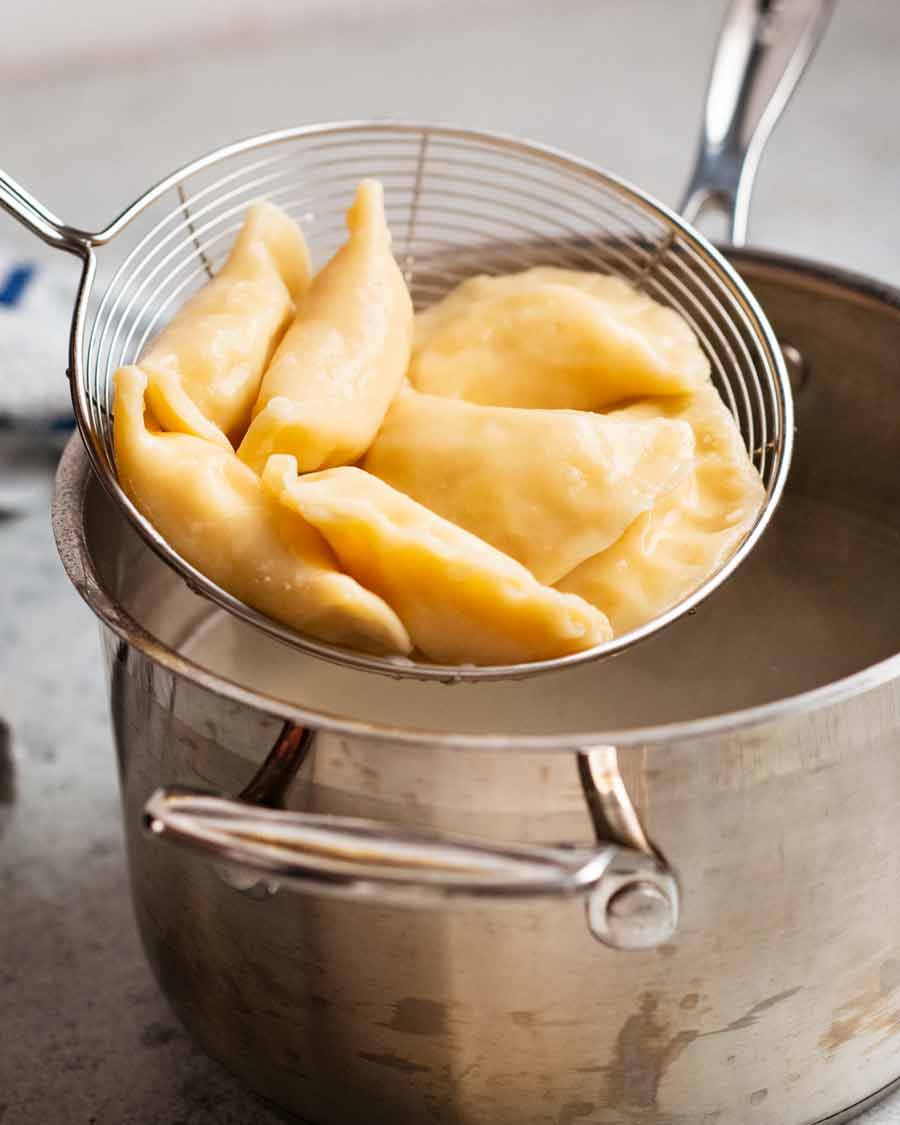

Ingredients in Pierogi
Very, very few!
THE Pierogi filling
It’s essentially cheesy, buttery, creamy mashed potato. See authenticity note below the photo on the cheese, and why it was important for me to make this recipe accessible to “everyone”!
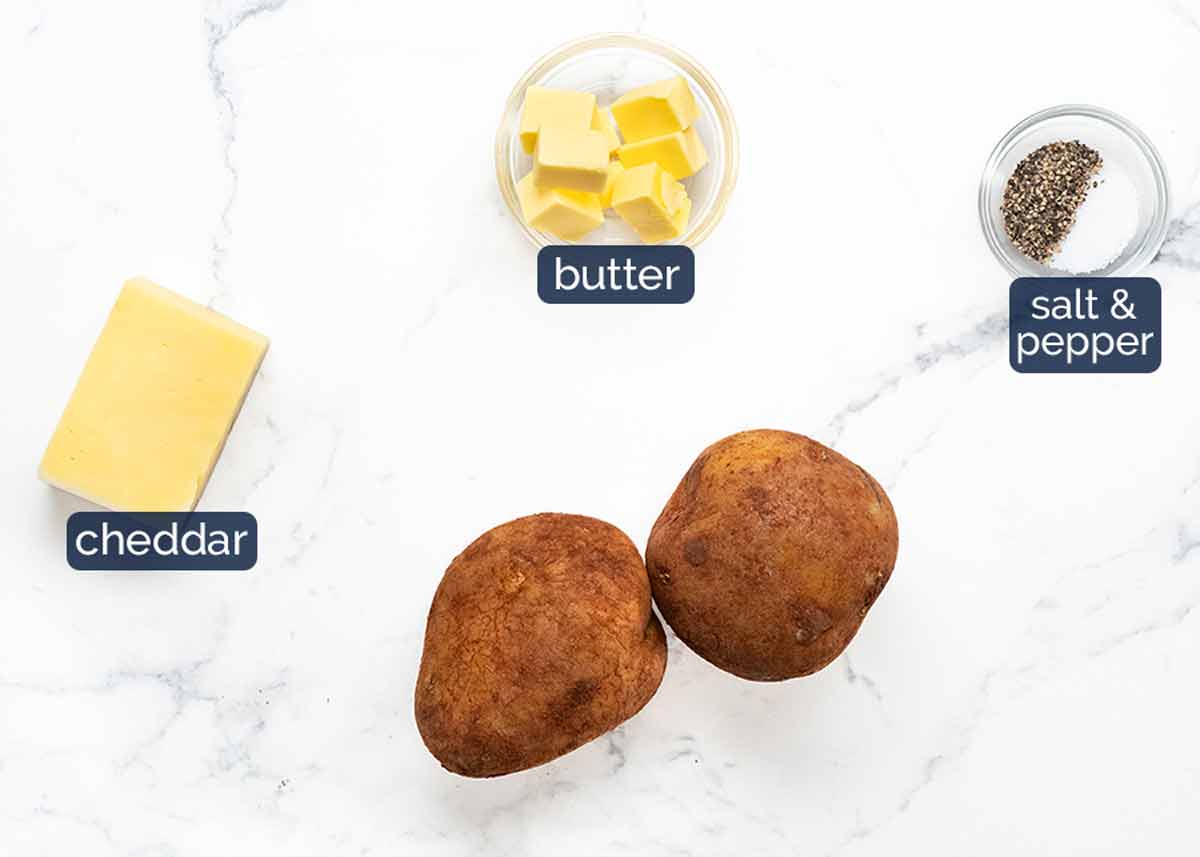
Potatoes – Use all-rounder potatoes so they mash up fluffy and creamy. The most common potatoes at regular stores will be fine – they’re stocked because they’re great all-rounders.
Australia – Sebago (the dirt brushed potatoes sold everywhere) are perfect, Desiree are great too. US: Yukon Gold, russet, UK: Maris piper, King Edward.
Cheese – I use cheddar but any good melting cheese you’d happily put in your grilled cheese is fine. Give mozzarella a miss. While it melts great, it doesn’t have enough flavour.
Authenticity note – Pierogi is traditionally made with quark, a mildly tangy European cottage cheese. Quark is not something I’ve seen frequently in Australia. Cottage cheese is probably the best substitute. But shredded cheese, as you can imagine, makes a delicious alternative – imagine it melted throughout creamy mashed potato!
I opted to use regular cheese because I want this recipe to be as accessible as possible so many people can experience the greatness that is Pieorgis.
Butter – Use unsalted so we can add the right amount of salt.
Pierogi DUMPLING DOUGH
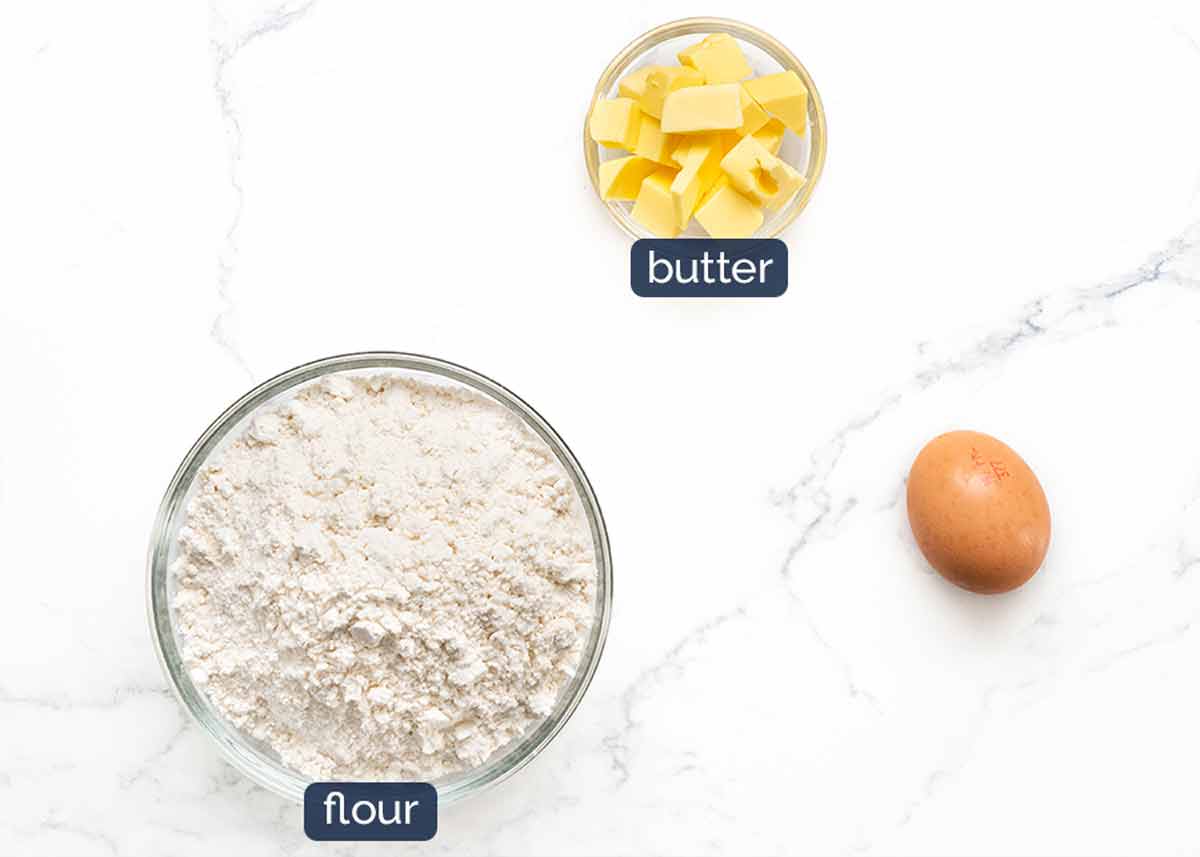
Flour – Just plain / all-purpose flour.
Large egg – From a carton labelled “large eggs” (they should weight around 55-60g/2 oz).
Butter – Melted into the water that I accidentally left out of the phot. 🙂
ONION BUTTER SAUCE
You could serve the Pierogis will just melted butter and you’d swoon. But it’s even better with a sautéed onion sauce which is common with traditional Polish Pierogis.

How to make Pierogi
Pierogis are easier to wrap than gyoza and potstickers. Because Asians like pleating – which can take practice to master. The Polish just press to seal. Much simpler! – I’m a big fan 🙂
HOT TIP: Got a Pierogi itch that needs scratching but homemade wrappers are out of reach? Use store-bought round Asian dumpling wrappers instead. The wrappers are thinner but it works a treat!
1. CHEESY POTATO FILLING FIRST
Make the filling first because it needs 1 1/2 hours to fully cool, during which time you’ll have the dough rolled out and cut, ready to fill!

Boil potatoes in salted water, starting with the potatoes in cold water. Why? Because otherwise the outside of the potatoes cook too much and start to crumble before the inside is cooked.
Drain potatoes.

Mash & mix – Pass the potatoes through a potato ricer or mash using a regular potato masher. Then mix in the butter, cheese, salt and pepper. The cheese won’t melt – it melts when the pierogis is boiled!
Cool – Spread out on to a tray. Cover with cling wrap, pressing so it is fully in contact, so the filling doesn’t sweat. Cool on the counter (about 30 minutes) then refrigerate until cold (1 hour+). You can do this the day before.
The filling needs to be cold so it doesn’t sweat inside the dough (which would make the dough soggy). It’s also easier to wrap the dumplings because the potato is firm.
2. how to make pierogi dumpling DOUGH
You could use your stand-mixer but I enjoy the leisurely process of hand-kneading this dough. It’s easy to manage because it’s a small amount and the dough is soft. Plus, hand-kneading is somewhat satisfying, and you can (smugly) tell everybody fortunate enough to eat one of these – I made these myself with my own hands. (You know I do!)

Dry – Whisk the flour and salt in a mixing bowl.
Add wet – Make a well in the centre. Then add melted butter with warm water plus the egg. Mix to combine using a spatula – it will be a rough, shaggy dough.
Knead – Scrape out onto a lightly floured work surface. Knead for 5 minutes until the dough becomes smooth. Use the bare minimum flour as needed to prevent it from sticking to your hands and the work surface. (Too much flour = drier stiffer dough = more difficult to roll out thinly).
Rest – Wrap with cling wrap and leave on the counter for 30 minutes.
3. MAKING THE PIEROGIS

Roll out the dough on a lightly floured surface to 3mm / 1/8″ thickness.
Cut out rounds using a 7.5 cm / 3″ cutter. Do as many as you can, then gather surplus dough into a ball, wrap with cling wrap and set aside to roll out and cut more later.

Filling – Place 1 tablespoon of cheesy potato filling in the middle of a round (20g, if you want to be exact!).
Dip finger with water and run along edge of half the circle. This will help seal securely.
Fold dough over to enclose the filling then press the edges together.
Seal firmly by pinching to make slight dents, the traditional look of pierogis.
Place them on a lightly floured tray and continue to wrap remaining Pierogi (including rolling out the remaining dough). You should get ~30 pierogis. A nice big batch – cook some now, freeze some for later!

4. HOW TO COOK PIEROGIS
Boil like pasta! Just make sure you don’t crowd the pot. Pierogis needs space to bounce around! I cook 8 in a medium pot, and up to 12 in a wider pot. Tips below for batching cooking larger quantities.

Sauté onion first – Sauté chopped onion in butter until golden on the edges. Then transfer into a bowl or container and use as much or as little as you want for whatever size serving of pierogis you are making. 1 large onion is enough for 30 pierogis because they are only sparingly scattered with onion, like pictured. Cook onion will keep for 5 days in the fridge, or freezer for 3 months.
Boil 5 minutes – Bring ~3 litres/quarts of water to the boil with 1 tablespoon of salt. Lower 10 pierogis into the water and cook for 5 minutes, or until they are floating on the surface (they sink at first).
⚠️ As noted above the step photos, don’t crowd the pot else the pierogis will stick together and cook unevenly.
⚡️ It’s important to use salted water so you get some seasoning into the pierogis wrapper as it cooks. Makes it tastier!

Reserve water – Dip a jug into the water and scoop out 1 cup water. We’re going to use a bit of this water to make the sauce. The cooking water is better than tap water because it’s got starch from the pierogi dough in it which makes the sauce thicken. If you just mixed water + butter together, it stays water.
Scoop out or drain – Then use a slotted spoon to transfer pierogi into a bowl. Or, you can drain in a colander if you are not using the water to cook more.

Butter sauce – Using a largish pan, melt 25g butter (1 1/2 tablespoons) over medium heat. Add 1/3 of the onion butter (from step 1) plus the cooked pierogis with 2 tablespoons of the reserved cooking water.
Toss for 1 minute, still on the stove, until the pierogis are coated in the butter sauce. You’ll see it goes from watery (when you first add the water) to thickened so it sticks to the surface of the pierogi.
Larger batch – Just scale up the butter, onion and water. At this stage, it’s easy to eye-ball it. And I wouldn’t discourage the use of even more butter!
Serve – Slide onto a serving plate, scraping out every drop of butter. Sprinkle with parsley, add a dollop of sour cream. Eat and be happy!

Big-batch cooking of Pierogi
As strange as it sounds to have a whole section on how to cook and serve larger batches of pierogi, there’s actually practical factors that come into play that need to be considered! The reason is because they are quite large – bigger than Gyoza and Chinese dumplings, you can’t boil more than 10 to 12 max per batch, and they need to be tossed in the sauce on the stove.
So the recipe I’m sharing today makes 30 pierogis but provides directions to cook one batch of 8 to 10 (which is a nice amount for 2 people). Leftovers are perfect for freezing – you can cook from frozen!
But if you would like to cook all 30 pierogis, here’s some practical tips for how to do it!
boiling large batches
Pierogis need to be boiled in a single layer else they can get stuck together and the wrapping won’t cook evenly. So you’ll max out at around 12 pierogis in a large home-pot.
If you want to make and serve more, then boil in batches of 12 and spread cooked pierogis on a tray. Once you’ve boiled as much as you want, then drop all of them back into the pot for 30 seconds to reheat before tossing with the butter. Reserve a mugful of the cooking water then drain in a colander.
Large batch butter sauce tossing
For the butter sauce tossing part, you can put in as many pierogis as you can comfortably fit into a large skillet. You could even use a large pot. Just make sure you can toss the pierogis, because that’s how you get a nice coating of butter on them.
Simple method for gigantic batches
If you want to serve all 30 pierogis at the same time, an easy way to sauce them up is to make the sauce separately then douse over the pierogis.
To do this, cook the pierogis per above (ie boil then reheat). Drain well in a colander and transfer into a serving bowl. Melt 70g / 4 1/2 tbsp unsalted butter with 1/3 cup of the cooking water in a small pan on medium heat. Simmer for a couple of minutes until the butter thickens (the starch in the pierogi cooking water makes this happen).

Serving pierogis
Cooking part done, it’s time to enjoy them! A dollop of sour cream adds a lovely cooling, tangy creamy touch that pairs so well with cheesy mashed potato (proof – reader favourite Stuffed Baked Potatoes!). And a little sprinkle of parsley or chives adds a nice touch of green to an otherwise very beige plate.
And as a plate of food that is an unapologetic celebration of three of my favourite food groups – butter, cheese and potato – a perky fresh side of greens would be a nice accompaniment. Even this self-confessed Cheese Lovin’ Carb Monster needs something fresh to cut through all that richness! Try a classic light vinaigrette with leafy greens or any steamed vegetables.
Hope you love this as much as we do! Big shout out to our Chef JB for doing much of the leg-work on the research, development and testing on this pierogi recipe, then teaching me and answering my many, many questions. It’s been raining pierogis in our kitchen!!! – Nagi x
Watch how to make it
Hungry for more? Subscribe to my newsletter and follow along on Facebook, Pinterest and Instagram for all of the latest updates.

Pierogi Ruskies – Polish Dumplings
Ingredients
Pierogi dough:
- 2 cups flour , plain/all-purpose
- 1 tsp cooking/kosher salt
- 50g / 3 tbsp unsalted butter
- 1/2 cup water
- 1 large egg , whisked (55-60g/2oz)
Pierogi filling:
- 500g / 1 lb potatoes , peeled and sliced 1cm / 1/2" thick (2 medium, Note 1)
- 1 tbsp cooking/kosher salt – for cooking potatoes
- 30g / 2 tbsp unsalted butter
- 1 cup shredded cheddar cheese , tightly packed cup (Note 2)
- 1/4 tsp cooking/kosher salt
- 1/2 tsp black pepper
Onion Butter:
- 30g/ 2 tbsp unsalted butter
- 1 onion , finely diced
- 1/2 tsp cooking/kosher salt
Cooking and serving:
- 1 tbsp cooking/kosher salt – for boiling water
- 25g/ 1 1/2 tbsp unsalted butter , per 8 – 10 pierogis (Note 3)
- Sour cream , for serving
- Parsley or chives , finely chopped – just a pinch
Instructions
Filling:
- Boil potatoes – Put potato and 1 tbsp salt in a large saucepan. Add cold tap water so it's 3cm/1 inch above potatoes. Bring to a boil on high heat then reduce heat to medium high and simmer for 15 minutes or until potatoes are soft.
- Mash – Drain, then pass the potatoes through a potato ricer into a bowl (or use potato masher)
- Cheese it – Immediately add butter, cheese, salt and pepper. Mix with a wooden spoon until fully combined.
- Cool – Spread out ~1cm / 1/2" thick on a tray. Cover with cling wrap, pressing so it is fully in contact. Cool on the counter (~30 min) then refrigerate until cold (1 hour+).
Pierogi Dough:
- Melt butter – Heat up the water and butter in a small saucepan over medium heat just until butter is melted, do not boil water. (Or do this in the microwave). Turn off heat.
- Mix dough – Whisk the flour and salt in a mixing bowl. Make a well in the centre and then add the butter water plus egg. Mix to combine into a shaggy dough.
- Knead – Scrape out onto a lightly floured work surface. Knead for 5 minutes until the dough becomes smooth (Note 3). You could also use your stand mixer.
- Rest – Wrap with cling wrap and leave on the counter for 30 minutes.
Wrapping pierogis:
- Roll & cut – On a lightly floured surface, roll out the dough to 3mm / 1/8" thickness. Cut out rounds using a 7.5 cm / 3" cutter. Do as many as you can, then gather surplus dough into a ball, wrap with cling wrap and set aside for later.
- Fill & wrap – Place 1 tablespoon of cheesy potato filling in the middle of a round. Dip finger with water and run along edge of half the circle. Fold dough over to enclose the filling and press to seal, making slight indents (no pleats).
- Wrap remaining – Place them on a lightly floured tray and continue to wrap remaining Pierogi (including rolling out the remaining dough). You should get ~30 pierogis.
Onion butter sauce:
- In a non stick skillet, melt the butter until foamy over medium heat. Add onion and salt, then cook, stirring regularly, for 10 to 15 minutes until golden on the edges. Scrape out into a bowl, then set aside (OK to cool).
Cooking & serving pierogis:
- Batch cooking – Directions below are for cooking and serving 10. Boil pierogis in batches of 10 to 12 max, they need space to bounce around in the water, and you need space to toss them in the butter. (Note 4 for big batch cooking)
- Boil 5 minutes – Bring ~3 litres/quarts of water to the boil with 1 tbsp salt. Lower 10 piergosi into the water. Cook for 5 minutes – they should be floating on the surface.
- Reserve water & drain – Dip a jug into the water and scoop out ~1 cup water. Then use a slotted spoon to transfer pierogi into a bowl (or drain, if not cooking more).
- Butter sauce – Melt butter in a large skillet over medium heat. Add 1/3 of the onion butter plus the cooked pierogis with 2 tablespoons of the reserved cooking water. Toss for 1 minute, still on the stove, until the pierogis are coated in the butter. (Note 4 on scaling up)
- Serve – Slide onto a serving plate, scraping out every drop of butter. Sprinkle with parsley, add a dollop of sour cream. Eat and be happy!
Recipe Notes:
Life of Dozer
Coming to you in real time! This is Dozer today, at a photography studio for a Christmas special edition of Good Food Australia with the A-team: Rob Palmer (photographer), Emma Knowles (food stylist), Theresa Klein (photo chef). Who ever imaged a discount dog would experience such things!!


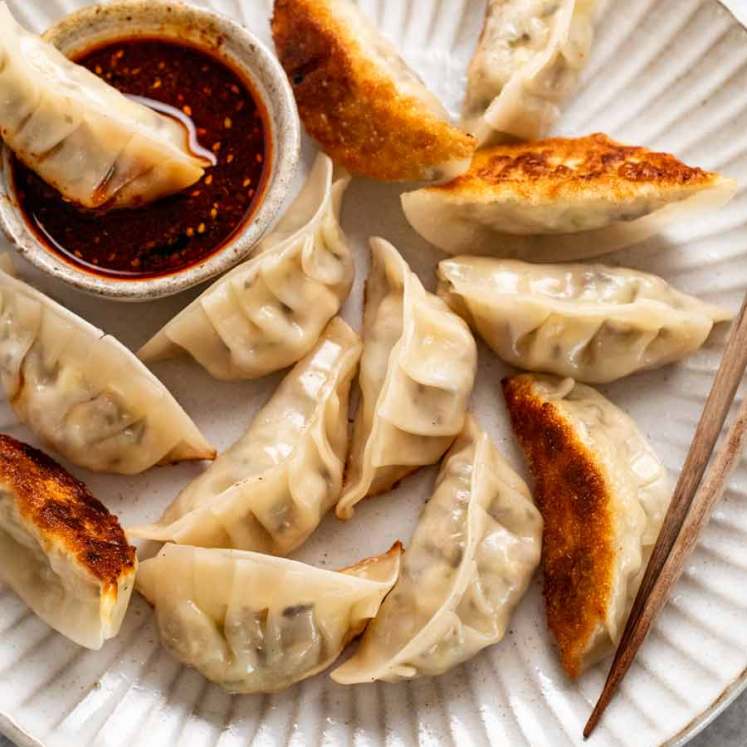
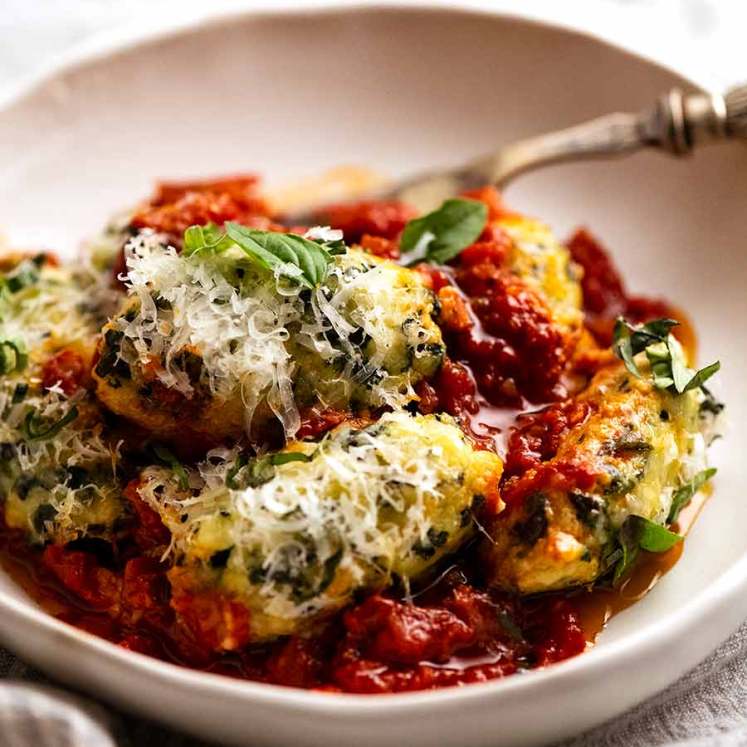

Pierogi are the best. In polish pierogi is the plural so no need for the s at the end 😂. My polish mother, auntie and godmother would get together and make batches of around 800. The dough had egg, the meat was put through the grinder, mushrooms cooked, quality sauerkraut squeezed dry. Took all day but after they were boiled they were fried in butter until crispy and served only with salted sour cream. We never had any other filling nor did Dom Polski in Adelaide. I don’t have the patience so I use Gow Gee wrappers from the Asian store, pork mince, rehydrated porcini mushrooms and along with the other ingredients cook the filling, fill and then fry. After years of boiling them just because my mum did I discovered if the filling is cooked that you just fry them in butter and oil until super brown and crispy. They are so good! Sorry for the long message but I was so excited to see a polish recipe on your amazing site. Love your recipes and have been telling everyone since I discovered it in 2016. If it’s not by Nagi, it’s not worth making is a motto used by many friends and family.
Could this recipe be converted to be gluten free?
Made this last night added fried onion As per comment but pumped it up by frying bacon first saving it for butter sauce
I added sage to the butter sauce and fried the pierogis in the sauce added reserved water at the end fantastic flavour with the bacon and sage
OMG!!! You dialled it up two notches! I wish I was at your house last night 🙂 So glad you loved it Robert! N x
Perfectly Delicious.
I also took a few and fried them in a little butter until golden. Perfect as a side with our hot dog lunch.
I’m so thrilled you enjoyed it Jennifer!!! Love that you pan fried until you got colour on them, I will try that next time – N x
I would like to pass on a time-saving technique that I learned many years ago. Completely soak a clean tea towel and wring out as much water as possible. The towel should just be damp. Lay the tea towel on a flat surface and, as you cut out your circles, place them in rows on the damp towel. When you have as many circles as you need, start with the first circle you placed on the towel and fill it in accordance with Nagi’s instructions. When you fold the dough over the filling to seal it, you should not need to use any additional water to make the dough stick together.
Perhaps a little easier than soaking and wringing out the tea towel, just use a spritzer or mister once the towel is laid flat to get the right level of moisture? Even just the lightest misting of the filled pierogis before sealing?
Hi Sharon, thank you for sharing your technique! We’ll definitely try it!
The Russian equivalent to a Polish pierog would be the vereniki. Meat filled Russian dumplings are called pelmeni. The baked Russian dumplings are called pirozhki.
If I wanted to use pre-made wrappers, which would be the best to use? Wonton wrappers maybe?
Hi Joy! I’d use gyoza wrappers – round ones 🙂 N x
Nagi has transformed her site and has been more than a valuable contributor to the culinary world. When I was young my mother, stepmother was able to obtain from the butcher Russian pies. These were a variation on pierogi and there are many varieties. I think she bought two types one which was me and was astounding. Such things do not exist in this day and age anymore sadly, and I don’t imagine that I could have a recreate that experience,.. possibly some meat and cabbage used.,
The Russian equivalent to a Polish pierogi would be the vereniki. Meat filled and boiled Russian dumplings are called pelmeni. The baked Russian dumplings with meat or vegetables are called pirozhki.
Fry with onion & bacon 🤤
I am totally trying that next time 🙂 N x
Pierogi are Central European stuffed dumplings. Now it’s correct.
How is it that I seem to be in sync with the timing of your recipes?
I’m in the middle of making a batch of quark (I live in rural Oz and there’s no way I can find it in a shop in these parts) plus I have about 6 potatoes left from our last season’s harvest that need using.
What a perfect recipe and perfect timing!
Wait, what?? Homemade quark?? *She instantly opens a new tab and googles*
I have a thermomix and homemade quark only requires 1000g sour cream light only….ridiculously simple in the thermie
Look I’m fan but for the love of food please change the title is completely misleading and basically butchery of what is very old traditional polish dish and while I’m sure it would taste great it is not what’s in the title.
Also quark is easily available in Australia just go to any polish/euro deli or easily make some yourself, it’s easy, alternatively replace it with cooking Philadelphia cream cheese, it would be a lot closer plus use authentic recipe, you need onion in the stuffing.
Once again not saying your recipe is bad just is not what you claim to be, not even close
Hi Tomasz! I’m sorry this upsets you, I did do my research and did a lot of testing to make sure we made a recipe that was respectful to traditional Pierogi. The one deviation we made was with the cheese but I made clear notes about it in the post and in the recipe card. I must confess I am not knowledgable about Polish delis here in Sydney so I can’t speak to accessibility. I just know that I do get out and about quite a lot when it comes to groceries but I haven’t noticed quark at delis I go to that are well stocked with European produce. Thank you for your input into the discussion! N xx
You didn’t upset me, and like I said it is clear that it will taste great but you shouldn’t call it ruskie pierogi because it is completely different dish that you did here and it even got its own name, it’s called pierogi with potatoes and yellow cheese but you still missing onion in stuffing,
My mother’s family is from Ukraine and they make a similar food called vareniki. My aunties used to make them with cottage cheese and raisins or ground meat with onions or with cherries. They always topped their vareniki with lots of SOUR CREAM because “You too skinny. You need to eat!” Hahahahahaaa
I don’t have that problem!!! Still doesn’t stop me from using LOTS of sour cream 😂
Must step other was able to buy from a butcher Russian pasties or pies when I was younger. That would be the nicest thing I’ve ever had and the closest thing to Pierogi. There were different types but I remember the meat type. Often these are more savoury and by savoury I mean not inclusive of meat but more of an appetiser excluding meat. Does that make sense? The word savoury seems to have changed in meaning…
Please use dill instead of parsley, delicious!
Oooh! I can imagine that! N x
My other favourite are the meat and cabbage ones. These are time consuming as you have to have a hand mincer to crush all the meat. But these are super yummy! Best the next day fried in a bit of butter!
Yuuuumm!!! I would love to try a meat and cabbage one! N x
Dozer has the BEST life! Love him!! Thanks for the pictures of him.
Thanks for another great recipe. I look forward to your emails, especially at the end about Dozer. I am cooking this recipe this weekend. I also enjoy cooking from your cookbooks. Again, THANK YOU!
I grew up in Poland eating those. They are wonderful! We make the stuffing a bit different – we add diced onion sautéed in butter to it and I think that is a must. Additionally dry curd cottage cheese or farmers cheese will taste more like a real thing than cheddar, but cheddar could be interesting, just not the same
I love this fried Pierogi recipe! In fact, I’ve been using a variation of this myself for many years and it is really delicious. I fry onion, garlic, bacon, and peppers in butter and then add the frozen pierogies until they are cooked through. Before serving, I toss in a bit of heavy cream and Herbs de Provence or Italian herbs and maybe a dash of Sherry. Where I live in Texas (US) we can buy excellent frozen pierogies very cheap. They absolutely cook from frozen very easily.
I’m a huge fan and supporter but this recipe would result in a thick heavy dough. Our family uses milk and sour cream in the dough. The result is a soft dough and a lighter perogy. I can email our recipe if you’d like to try it. It is amazing.
Hi Nagi! I’m Polish living in Poland, my family lives in Sydney. After visiting AUS few times I found your website and using your recipes (mainly asian meals) for the few years. Polish Pierogi (using Polish name of a dish is fabolous:D) made by my Mama, Babcia (grandmother) have a ground sour cottage cheese instead of “yellow cheese” (cheddar in your recipe). A cottage cheese is ground with potatoes and fried onion. I highly recommend to try this one!